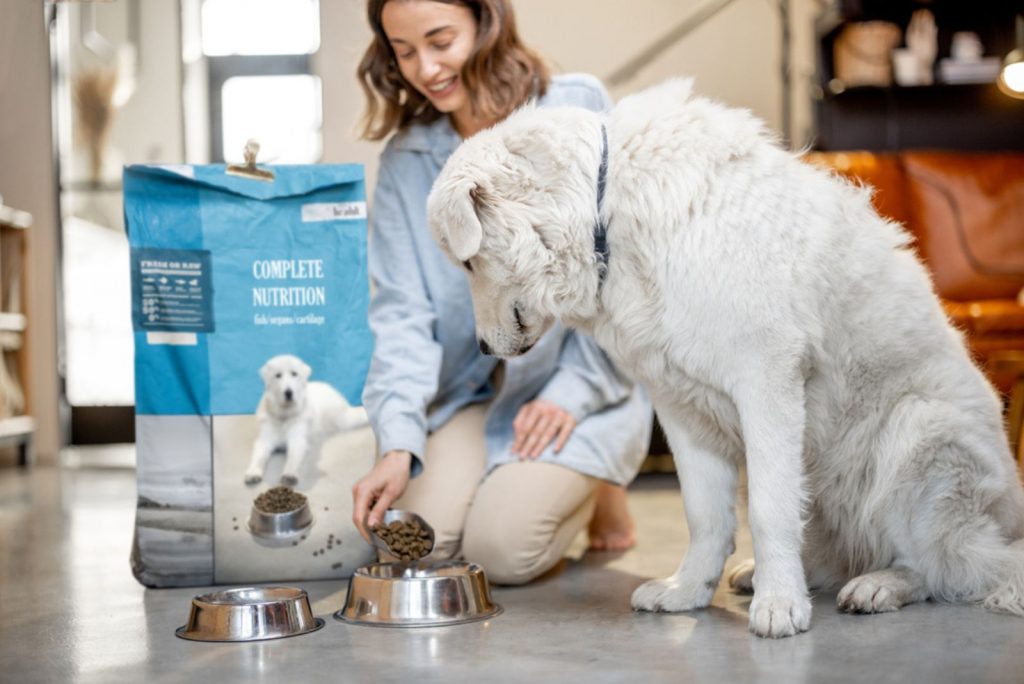We often keep telling dog owners to look out for what kind of food they buy for their dogs, but rarely do we mention how to sift through the mini novel that’s found on the back of the bag which is why people often ask us how to read dog food labels.
While it may seem daunting at first, learning how to read dog food labels will become a lot easier once you understand a few fundamentals that go into the formatting of every food label out there, canine or otherwise.
They’re all essentially the same and the ingredients and other information are ordered properly based on the current standard to make it easier to find the info that you’re particularly interested in without having to spend several minutes deciphering everything.
Aside from name and weight, you’ll first notice the listed nutrients after which come the actual ingredients sorted by weight from heaviest to lightest.
The rest is often tied to some extra information about life stage adequacy, the intended feeding chart and feeding directions in general as well as the calorie count in X amount of food.
This is the general overview of things, but there’s still some nitty gritty in there to decipher too.
If you’d like to learn how to navigate these massive walls of text with relative ease, then feel free to read on to soak some of these tips up.
9 Top Things To Know How To Read Dog Food Labels
1. Knowing The Order Of Things

The first and most basic rule that one needs to learn when reading dog food labels is the order of information given.
It’s the main thing that’ll help you orient yourself when trying to look up specific information about a product so it doesn’t take you minutes at a time per each individual one to find out whether they have a particular nutrient or not, for instance.
The order goes as follows:
- Name of brand and product
- Amount of received product (kg, lbs, oz, l, etc, depending on the type of food)
- The specific nutrients and their amounts
- Ingredients sorted in order of weight from heaviest to lightest
- Confirmations on how safe the food is to eat and who it’s intended for
- Feeding charts and similar instructions
- Food packager and manufacturer’s name and address
- Calorie chart or individual counts depending on product.
Some others may have some other different inherent stuff there, but it should all end up being listed after the rest of this list has been down.
With all that in mind, it’s time to go down the list to figure out what each of them means.
2. The Name Of The Product
The name of the product is more than just branding, it often shows the potential buyers what the most important part of said product is.
For example, Taste of The Wild tells us that they pride themselves on using the meat of wild game to add a unique spin to their kibble, bison in particular whereas Hill’s Science tells us that the product is more oriented toward a healthy diet that’s carefully measured.
That said, the name isn’t just the brand bit, but the extra “X flavor” text as well, that way the more abstract brand names can more easily convey what their product contains and the potential buyer can make a more informed decision.
In fact, there are a few specific rules that the AAFCO (Association of American Feed Control Officials) regulates these particular names by:
- The 95 percent rule – Where 95% of the name needs to contains the name of the ingredients used
- The 25 percent rule – Where 25% of the name needs to be the main ingredient
- The flavor rule – Where the flavor of the food is written down and needs to be present in a specific amount that would help convey that flavor
- The “With” rule – Where the added “with X ingredient” said X ingredient needs to have at least a 3% presence within the ingredient list to qualify.
Of course, you’re not expected to remember these, but do try and keep the hierarchy here in mind where, the clearer the name is, the more honest (and flavorful) the food is, in most cases.
3. Food Quantity

For those of you who like to do pinpoint calculations on the best deals, knowing the quantity of the food is one of your most valuable pieces of information.
More often than not, companies will try selling larger quantities of food at, what appear to be, good prices, but a little bit of quick math on the phone calculator and you can determine what the cost per pound really is.
This can greatly help you when you’re debating between two different brands and can be the tiebreaker you need to make that decision.
4. The Nutrient List
Now we move on to the back of the bag where we start reading through the fine print.
The first on the list should be the list of nutrients that the food should contain.
The next thing you’re likely to spot is the percentage of protein and fat in the food followed by the water and fiber content which are still relevant, albeit slightly less than the first two.
Protein and fat percentages can vary wildly, so be sure to know what the ideal ratio is for your dog’s breed.
You don’t have to be too specific, but there are certain preferences for each breed and following them will make it easier to manage both his weight and needed daily food intake.
Aside from these particular percentages, you’re going to find other relevant nutrient and vitamin info here, and, if mentioned, should also mention the exact amount of said vitamin or nutrient contained.
This is done to prevent companies just adding traces of a particular nutrient in an attempt to edge out ahead of the competition while swindling their customers.
The particular nutrients that are favorable for dogs are:
- Calcium and phosphorus – Healthy bone growth
- Glucosamine and chondroitin – Cartilage and bone maintenance
- DHA and EPA – For healthy cognitive development
- Omega-3 fatty acids – Better fur and skin health as well as overall bodily health
- Probiotics – Strengthen the immune system
- Antioxidants – Prevent cell damage by shielding them from free radicals
These are just a few of many more, but these are often the most sought after ones.
5. The Ingredient List
After these, you’re going to be getting the ingredient list, arguably the most important part, at least in regards to your dog’s preferences.
These are listed in order of weight so that you know which ingredient is the most prevalent, and, once again, to prevent any potential fraud from brands.
6. Who The Food Is Intended For

The next tidbit of information that you should be noticing is which particular life stage of a dog the food is intended for.
While the protein to fat ratios can help determine that somewhat at the start for the more educated pet parent, these ones spell it out a bit more clearly whether it’s puppy, adult, or senior dog oriented.
The picture on the front will usually match the intended life stage as well.
That said, there are some foods which are carefully balanced to be appropriate for all life stages, so it’s better to trust the writing on the back than the picture on the front.
7. A Feeding Chart
The next thing that you should be seeing is a feeding chart, often placed there as a general guideline on how much of the food is recommended for what dog size.
Do keep in mind that, unless the food is specifically tailored for a particular dog breed, this will be a generic feeding chart that doesn’t focus on your dog’s particular daily food intake.
So, if you can afford the time, look one up yourself instead and adjust accordingly.
That said, it should be easy enough to adapt his diet depending on visible weight loss or gain
8. Information On Where The Food Is Manufactured
This is one of the less relevant bits of info, but it does help the consumer learn where the food is being manufactured, who packages it so that you can look into it if you’re concerned about potential issues in quality.
9. Calorie Chart

Finally, you should be seeing a chart or a list of calories approximately contained in a set quantity of the food.
This is to help you better gauge how much food you should be giving your dog to satisfy his daily allotted calories.
Be Careful Of Deceptive Labels
As regulations get tighter, the companies end up becoming more innovative as a result, utilizing new words to try and prop their brand up while masking the actual quality of the food.
Some of the labels can be downright confusing too as they’re too generic like “Organic”.
There is no specific list of ingredients that are considered “organic” or a particular check given the variety of methods of procurement, so they’re not the best indicator of a quality product unlike nutrient and ingredient lists.
What To Avoid In Dog Food?
Not all ingredients included are healthy for your pooch, there are some used to cut costs in production or to prolong the shelf life of said food which should be avoided if possible.
Any artificial ingredients, preservatives and additives of any kind are what you should steer clear of as they’re often signs of a low quality product.
Meat by-product is usually not great either as it’s often there to just serve as a source of empty calories.
Sure, some of it may be good if it’s taken from the more nutrient rich parts of the animal like the liver, but most of it isn’t, so it’s better to be safe than sorry if you can afford it.
Finally, grains in dog food are a bit of a contested topic.
While normally good for nutrition, a sizable number of dogs can have grain allergies. Before you get the food, make sure you know what your dog’s food allergies are, if any.
If he does possess a grain allergy, then it’s another ingredient to be careful of.
The 3 most common grains in dog food are wheat, corn and soy.
In Conclusion
Knowing how to read dog food labels can be an extremely helpful skill as a pet parent as it can serve to greatly improve your dog’s quality of life by helping avoid bad ingredients and telling you whether or not you’ll be able to meet his daily nutritional needs.
On top of that, it can help you save money by going for better, more quality food that may be cheaper than what’s touted as a popular brand.
It’s not rare to find a diamond in the rough when you know what you’re looking for.
Hopefully these skills aid you in your dog owning journey and make your furry friend healthier for it.
Until next time, pet parents!
RELATED LINKS:
- 7 Healthiest And Best Dog Food For Australian Shepherd Choices
- 7 Best Dog Food For Sheepadoodle: The Nutrition Your Dog Needs
- Homemade Dog Food For Belgian Malinois Benefits (+Recipe)
- Best Dog Food For A Cocker Spaniel: Top 18 Choices For Your Pup
- Homemade Dog Food For Pitbulls: Try Out 6 Easy Recipes
- 10 Best Non Prescription Dog Foods For Urinary Health
- 15 Best Dog Food For German Shepherds: Top Yummy Choices
